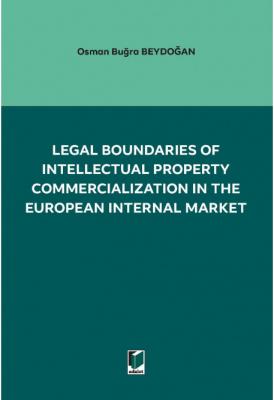Legal Boundaries of Intellectual Property Commercialization in the European Internal Market ( BEYDOĞAN )

The present work is adapted from the doctoral dissertation of the author, submitted to the University of Debrecen Géza Marton Doctoral School of Legal Studies (Hungary) in May 2021 and defended in June 2021.
The kick-off challenge facing the European intellectual property (IP) laws is hardly less apparent to those outsiders (much like the present author once was) than it is to native European lawyers and scholars. On the one hand rests the emblematic market model of the Union (i.e. the EU Internal Market) characterized by the free movement principle and the objective of undistorted competition. On the other hand is the typology of IP rights that is characteristically exclusive -thus exclusionary- and historically territorial. The two phenomena are prone to come to an inherent and immediately conflict insofar as the territorial monopolistic rights stemming from IP protection, when exercised in respect of corporeal goods and services, present a major impediment to cross-border movement of corporeal goods and provision of such services.
Along these lines, the national IP rights made its debut in the modern European scene as an integrational -thus existential- and perpetual challenge before the European Union (EU). It is this -almost natural- contrast that brought the present author to be inquisitive of the continuum of reconciling these two intransigents. The curiosity, along the way, translated into critical and occasionally appreciative appraisal; the latter, however, is not necessarily because the said continuum was by any means magical, but rather because how progressively the IP practice has been jurisprudentially and legislatively tailored to fit the existential policy objectives of the Union on many fronts. With the postulates that (i) the very inception of an EU IP law above the national ones is directly (and perhaps exclusively) attributable to the idiosyncrasy of the unique market model that serves as the prime medium of European integration and that (ii) the legal boundaries of IP commercialization in the EU Internal Market are collectively marked by the free movement principle and competition rules of the Union, the present works sets about exploring these boundaries on various fronts, including the internal premises of IP law as well as that of competition law.
In contextual terms, there two points author feels the need to expressly elucidate. Firstly, references made, throughout the study, to judicial processes involving the United Kingdom covers pre-Brexit stage, where the UK was a part of the Internal Market. Secondly, the formal and methodological reason for the author’s refrainment from addressing patent exhaustion in a separate chapter needs to be highlighted. By the time of compilation of this study, the Unified Patent Court Agreement (and concordantly the Unitary Patent Regulation) had not come into force. Concordantly, albeit the aforementioned legislation encompasses exhaustion provision and its limitations having been formulated as “legitimate reasons”, there is no Union legal order (yet) that has shaped around (or come to interpret) thereof at the Union level. Therefore, the appraisal of these definitions, in the absence of judicial interpretation, would be of speculative nature, in contrast to general analytic profile of the present study. With that, the general consideration of patent exhaustion and certain specific situations have been addressed in the doctrinal part, subsumed under the Chapter 4 of this work. On a final note, it goes without saying that the present work stands only to be the nucleus of an exploratory undertaking that has yet to expand, further and continuously.
- Açıklama
The present work is adapted from the doctoral dissertation of the author, submitted to the University of Debrecen Géza Marton Doctoral School of Legal Studies (Hungary) in May 2021 and defended in June 2021.
The kick-off challenge facing the European intellectual property (IP) laws is hardly less apparent to those outsiders (much like the present author once was) than it is to native European lawyers and scholars. On the one hand rests the emblematic market model of the Union (i.e. the EU Internal Market) characterized by the free movement principle and the objective of undistorted competition. On the other hand is the typology of IP rights that is characteristically exclusive -thus exclusionary- and historically territorial. The two phenomena are prone to come to an inherent and immediately conflict insofar as the territorial monopolistic rights stemming from IP protection, when exercised in respect of corporeal goods and services, present a major impediment to cross-border movement of corporeal goods and provision of such services.
Along these lines, the national IP rights made its debut in the modern European scene as an integrational -thus existential- and perpetual challenge before the European Union (EU). It is this -almost natural- contrast that brought the present author to be inquisitive of the continuum of reconciling these two intransigents. The curiosity, along the way, translated into critical and occasionally appreciative appraisal; the latter, however, is not necessarily because the said continuum was by any means magical, but rather because how progressively the IP practice has been jurisprudentially and legislatively tailored to fit the existential policy objectives of the Union on many fronts. With the postulates that (i) the very inception of an EU IP law above the national ones is directly (and perhaps exclusively) attributable to the idiosyncrasy of the unique market model that serves as the prime medium of European integration and that (ii) the legal boundaries of IP commercialization in the EU Internal Market are collectively marked by the free movement principle and competition rules of the Union, the present works sets about exploring these boundaries on various fronts, including the internal premises of IP law as well as that of competition law.
In contextual terms, there two points author feels the need to expressly elucidate. Firstly, references made, throughout the study, to judicial processes involving the United Kingdom covers pre-Brexit stage, where the UK was a part of the Internal Market. Secondly, the formal and methodological reason for the author’s refrainment from addressing patent exhaustion in a separate chapter needs to be highlighted. By the time of compilation of this study, the Unified Patent Court Agreement (and concordantly the Unitary Patent Regulation) had not come into force. Concordantly, albeit the aforementioned legislation encompasses exhaustion provision and its limitations having been formulated as “legitimate reasons”, there is no Union legal order (yet) that has shaped around (or come to interpret) thereof at the Union level. Therefore, the appraisal of these definitions, in the absence of judicial interpretation, would be of speculative nature, in contrast to general analytic profile of the present study. With that, the general consideration of patent exhaustion and certain specific situations have been addressed in the doctrinal part, subsumed under the Chapter 4 of this work. On a final note, it goes without saying that the present work stands only to be the nucleus of an exploratory undertaking that has yet to expand, further and continuously.
Stok Kodu:9786258209778Boyut:16.5x23.5Sayfa Sayısı:326Basım Yeri:ANKARABaskı:1Basım Tarihi:EKİM 2022Kapak Türü:Karton KapakKağıt Türü:1.hamurDili:İngilizce
- Taksit Seçenekleri
- Diğer KartlarTaksit SayısıTaksit tutarıGenel ToplamTek Çekim359,10359,10
- Yorumlar
- Yorum yazBu kitabı henüz kimse eleştirmemiş.











